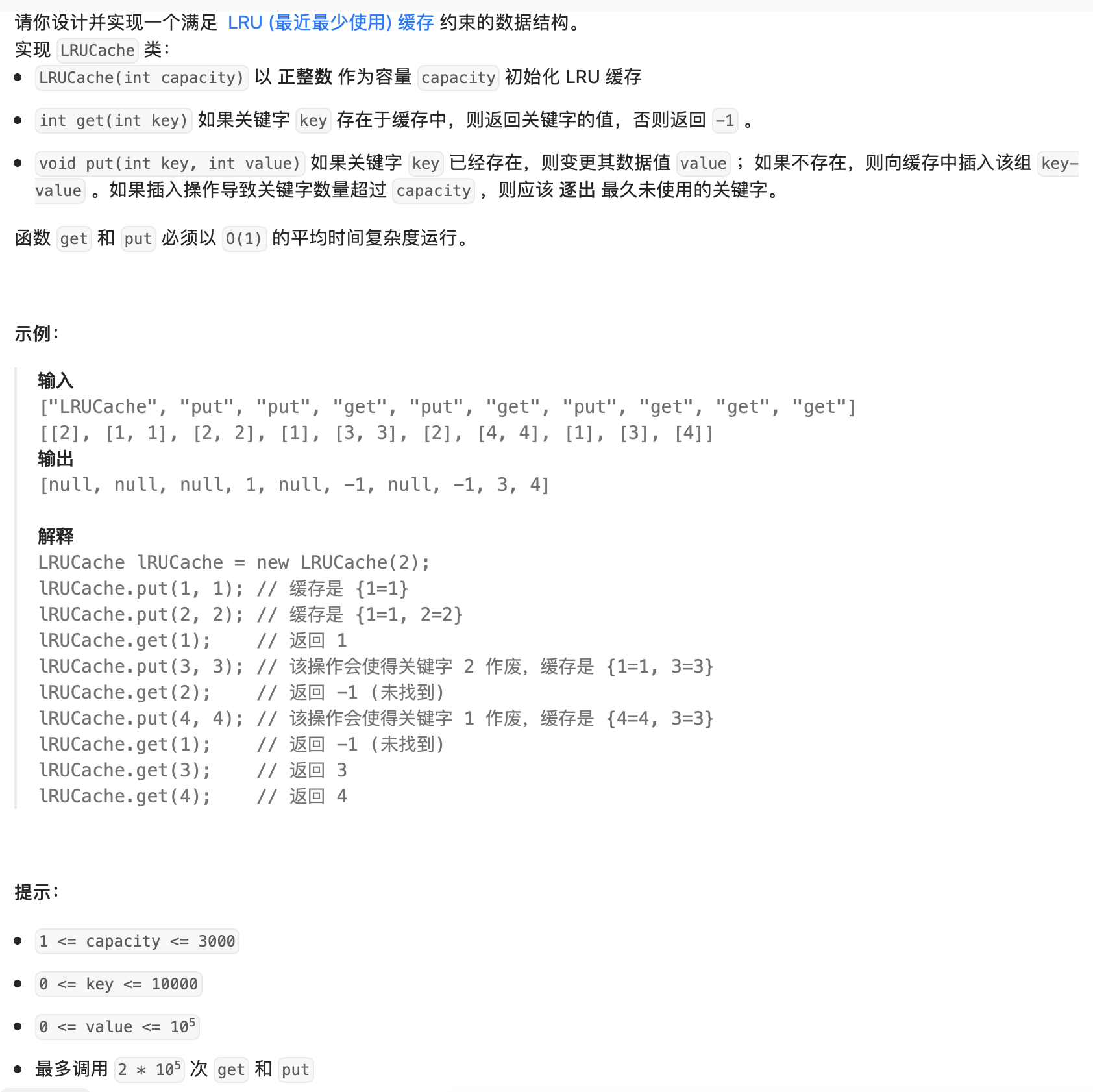请你设计并实现一个满足 LRU (最近最少使用) 缓存约束的数据结构。
这是一道大厂面试高频出现的算法题,难度为⭐️⭐️⭐️,属于中等,老铁们来一起看看这个题该怎么解?
1. 原题再现

没有废话,翠花,上酸菜!
2. 具体实现
为了实现一个满足 LRU (最近最少使用)缓存约束的数据结构,我们需要一个能够快速访问、更新和删除的数据结构,V 哥想到了用哈希表,因为哈希表提供了快速的查找能力,但是它不能保持元素的顺序;而双向链表可以保持元素的顺序,并且可以在 O(1) 时间复杂度内进行插入和删除操作。因此, V哥采用结合使用哈希表和双向链表来实现LRU缓存。
以下是 Java 代码实现:
import java.util.HashMap;class Node {int key;int value;Node prev;Node next;public Node(int key, int value) {this.key = key;this.value = value;}
}public class LRUCache {private HashMap<Integer, Node> cache;private Node head, tail;private int capacity;private int count;public LRUCache(int capacity) {this.capacity = capacity;this.cache = new HashMap<>();this.head = new Node(0, 0);this.tail = new Node(0, 0);this.head.next = this.tail;this.tail.prev = this.head;this.count = 0;}public int get(int key) {Node node = cache.get(key);if (node == null) {return -1;}moveToHead(node);return node.value;}public void put(int key, int value) {Node node = cache.get(key);if (node == null) {Node newNode = new Node(key, value);cache.put(key, newNode);addNode(newNode);count++;if (count > capacity) {Node toDel = popTail();cache.remove(toDel.key);count--;}} else {node.value = value;moveToHead(node);}}private void addNode(Node node) {node.prev = head;node.next = head.next;head.next.prev = node;head.next = node;}private void removeNode(Node node) {node.prev.next = node.next;node.next.prev = node.prev;}private void moveToHead(Node node) {removeNode(node);addNode(node);}private Node popTail() {Node res = tail.prev;removeNode(res);return res;}
}
使用示例:
public class Main {public static void main(String[] args) {LRUCache lRUCache = new LRUCache(2);lRUCache.put(1, 1); // 缓存是 {1=1}lRUCache.put(2, 2); // 缓存是 {1=1, 2=2}System.out.println(lRUCache.get(1)); // 返回 1lRUCache.put(3, 3); // 该操作会使得关键字 2 作废,缓存是 {1=1, 3=3}System.out.println(lRUCache.get(2)); // 返回 -1 (未找到)lRUCache.put(4, 4); // 该操作会使得关键字 1 作废,缓存是 {4=4, 3=3}System.out.println(lRUCache.get(1)); // 返回 -1 (未找到)System.out.println(lRUCache.get(3)); // 返回 3System.out.println(lRUCache.get(4)); // 返回 4}
}
输出结果应该与题目中的示例输出一致。这个实现使用了哈希表来快速查找节点,同时使用双向链表来维护节点的顺序和实现快速插入和删除操作。这样,我们就可以在 O(1) 的时间复杂度内完成 get 和 put 操作。
实现过程和步骤如下:
-
定义一个 Node 类,用于双向链表的节点,包含 key、value 以及前驱和后继节点的引用。
-
在 LRUCache 类中,定义一个 capacity 表示缓存的最大容量,一个 count 表示当前缓存中的节点数量,一个 cache 哈希表用于存储键和节点的映射,以及 head 和 tail 虚拟节点用于简化双向链表的操作。
-
实现 get 方法,首先在哈希表中查找键对应的节点,如果节点不存在,返回 -1。如果节点存在,则将该节点移动到链表的头部,表示最近被使用,然后返回节点的值。
-
实现 put 方法,如果键在哈希表中不存在,创建一个新的节点,并将其添加到链表的头部,同时添加到哈希表中。如果插入后节点数量超过了容量,则需要移除链表尾部的节点,并从哈希表中删除对应的条目。如果键已经存在,则更新对应的节点值,并将其移动到链表头部。
-
addNode 方法用于将节点添加到链表头部,removeNode 方法用于从链表中移除节点,moveToHead 方法用于将节点移动到链表头部,popTail 方法用于移除链表尾部的节点。
-
在 Main 类的 main 方法中,我们创建了一个 LRUCache 实例,并执行了一系列的 put 和 get 操作来演示其功能。
V哥认为这个实现确保了 get 和 put 操作的平均时间复杂度为O(1)。get 操作直接通过哈希表查找节点,而 put 操作中,无论是更新现有节点还是添加新节点,都涉及到对双向链表的操作,这些操作的时间复杂度都是 O(1)。当缓存达到容量上限时,put 操作会移除最久未使用的节点,这也是 O(1) 时间复杂度的操作。
3. 小结一下
V哥的这个实现的关键在于维护一个双向链表,它可以帮助我们快速地访问、更新和删除最近最少使用的节点,同时使用哈希表来提供快速的查找能力。这样,我们就可以在 O(1) 的时间复杂度内完成所有的缓存操作。哈哈干净利索,回答完毕。

)







)



)





